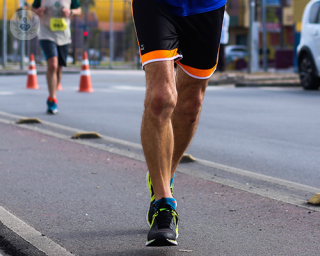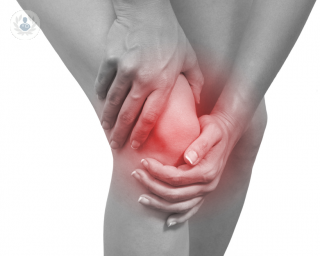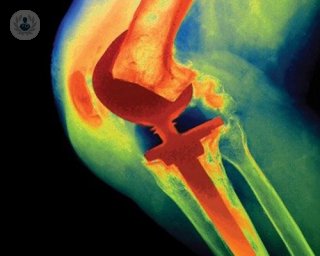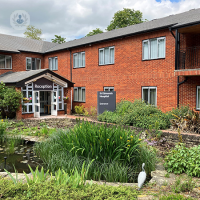Knee replacement
Professor Lee Jeys - Orthopaedic surgery
Created on: 11-13-2012
Updated on: 01-10-2024
Edited by: Conor Dunworth
What is knee replacement surgery?
Knee replacement surgery is a procedure that involves removing and replacing a damaged or worn knee joint with an artificial implant. An implant is placed in the damaged structure and replaces its function, allowing you to move the joint again, eliminating any pain you might have had before.
During the operation, the damaged bone and cartilage are removed. For this purpose, either a general or regional anaesthetic will be administered. The anaesthetist and orthopaedic surgeon will decide which to use in order to minimise discomfort as much as possible.

Why is knee replacement surgery performed?
The main reason for knee replacement surgery is because of osteoarthritis of the knee, which damages the joint. A knee prosthesis or implant may also be required in the case of fractures that have caused significant damage to the subchondral bone, or in the case of specific bone tumours.
What does knee replacement surgery involve?
Knee replacement surgery takes around two hours and involves removing the damaged cartilage and bone from the joint and replacing them with artificial implants. These implants can be placed in different parts of the knee: the lower end of the femur (metal piece), the upper end of the tibia (piece made of strong plastic and metal), or at the back of the kneecap (made of strong plastic).
Once the anaesthetic has been administered, the orthopaedic surgeon will make an incision of around 20 cm long in the joint to open it. The procedure is as follows:
- The patella is removed and a cut is made in the end of the femur and tibia to accommodate the prosthesis in the joint space
- The lower part of the kneecap is also cut so that the new piece fits well
- The two parts of the prosthesis are fixed to the different bones, one to the femur and the other to the tibia, using cement or screws
- The tendons and muscles of the joint are repaired and the incision is closed.
Depending on the injury and the amount of bone removed, the knee replacement may be:
- Total or tricompartmental: the joint and kneecap are completely replaced. This is carried out with rigid axis prostheses (rarely used because they only allow a single movement, flexion-extension), joint surface replacement prostheses (isolated resection of the damaged joint), prostheses with linked components (these provide good stability due to the link between the tibia and the femur, as well as flexion-extension and rotation movements, but they are no longer used) and self-supporting prostheses (these replace the damaged surface and their design provides stability and functionality. The most common type is the medial pivot prosthesis).
- Unicompartmental : used for limited joint injuries. The prostheses usually have a metal femoral component that is placed in the damaged femoral condyle, and a polyethylene component that is placed in the tibial part.
Preparing for a knee replacement:
The orthopaedic surgeon and anaesthetist will advise you on what you need to do before the procedure. You must tell them about any medication you are taking, so that it does not interfere with the outcome of the surgery. The specialist will perform a series of preoperative tests, such as an electrocardiogram, MRI scan, x-rays and other procedures that will make the surgery easier and allow them to access the joint with full knowledge of the injury.
Post-operative care:
After knee replacement surgery, you must strictly follow the advice of the surgeon and physiotherapist for a complete and successful recovery. The physiotherapist will design a series of personalised exercises for you, adapted to the type of injury. These exercises will increase in intensity as the mobility of the joint increases. The objective is to regain and increase muscle strength, correct any instability or deformity, relieve any pain you may have, eliminate any scar adhesions and improve your physical function.
The rehabilitation process also includes a number of other recommendations: to alternate flexion and extension movements when sitting, wear comfortable and well-fitting footwear, avoid sudden changes in weight to avoid overloading the joint, remove any furniture that may cause you to stumble or fall, do exercises at home (as recommended by the specialist), apply ice to the area after rehabilitation exercises, follow the instructions of the specialist for sitting, walking and going down stairs and, above all, keep the wound clean and disinfected.
Alternative treatments:
There is no alternative to knee replacement surgery. It is only performed in extreme cases, when the joint is severely damaged and the injury cannot be resolved with other procedures or treatments. The specialist will study the injury and decide on the best treatment or alternative.

















